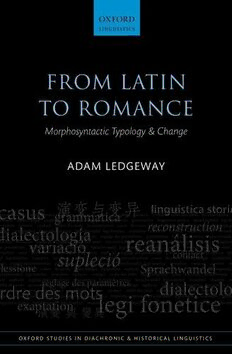
From Latin to Romance: Morphosyntactic Typology and Change PDF
Preview From Latin to Romance: Morphosyntactic Typology and Change
From Latin to Romance OXFORD STUDIES IN HISTORICAL AND DIACHRONIC LINGUISTICS GENERAL EDITORS AdamLedgewayandIanRoberts,UniversityofCambridge ADVISORY EDITORS CynthiaAllen,AustralianNationalUniversity;RicardoBermúdez-Otero,Univerisity ofManchester;TheresaBiberauer,UniversityofCambridge;CharlotteGalves,State University of Campinas; Geoff Horrocks, University of Cambridge; Paul Kiparsky, Stanford University; Anthony Kroch, University of Pennsylvania; David Lightfoot, Georgetown University; Giuseppe Longobardi, University of Trieste; David Willis, UniversityofCambridge PUBLISHED 1 FromLatintoRomance AdamLedgeway 2 ParameterTheoryandLinguisticChange EditedbyCharlotteGalves,SoniaCyrino,RuthLopes,FilomenaSândalo,and JuanitoAvelar Inpreparation TheBoundariesofPureMorphology DiachronicandSynchronicPerspectives EditedbySilvioCruschina,MartinMaiden,andJ.C.Smith TheHistoryofNegation Vol.I:CaseStudies;Vol.II:PatternsandProcesses EditedbyAnnaBreitbart,ChrisLucas,andDavidWillis GenderfromLatintoRomance MicheleLoporcaro VowelQuantityfromLatintoRomance MicheleLoporcaro WordOrderinOldItalian CeciliaPoletto SyntacticChangeandStability JoelWallenberg From Latin to Romance Morphosyntactic Typology and Change ADAM LEDGEWAY 1 3 GreatClarendonStreet,OxfordOX26DP OxfordUniversityPressisadepartmentoftheUniversityofOxford. ItfurtherstheUniversity’sobjectiveofexcellenceinresearch,scholarship, andeducationbypublishingworldwidein Oxford NewYork Auckland CapeTown DaresSalaam HongKong Karachi KualaLumpur Madrid Melbourne MexicoCity Nairobi NewDelhi Shanghai Taipei Toronto Withofficesin Argentina Austria Brazil Chile CzechRepublic France Greece Guatemala Hungary Italy Japan Poland Portugal Singapore SouthKorea Switzerland Thailand Turkey Ukraine Vietnam OxfordisaregisteredtrademarkofOxfordUniversityPress intheUKandincertainothercountries PublishedintheUnitedStates byOxfordUniversityPressInc.,NewYork #AdamLedgeway2012 Themoralrightsoftheauthorhavebeenasserted DatabaserightOxfordUniversityPress(maker) Firstpublished2012 Allrightsreserved.Nopartofthispublicationmaybereproduced, storedinaretrievalsystem,ortransmitted,inanyformorbyanymeans, withoutthepriorpermissioninwritingofOxfordUniversityPress, orasexpresslypermittedbylaw,orundertermsagreedwiththeappropriate reprographicsrightsorganization.Enquiriesconcerningreproduction outsidethescopeoftheaboveshouldbesenttotheRightsDepartment, OxfordUniversityPress,attheaddressabove Youmustnotcirculatethisbookinanyotherbindingorcover andyoumustimposethesameconditiononanyacquirer BritishLibraryCataloguinginPublicationData Dataavailable LibraryofCongressCataloginginPublicationData LibraryofCongressControlNumber:2011945220 TypesetbySPIPublisherServices,Pondicherry,India PrintedinGreatBritain onacid-freepaperby MPGBooksGroup,BodminandKing’sLynn ISBN 978–0–19–958437–6 1 3 5 7 9 10 8 6 4 2 Contents Seriespreface ix Listoftables xi Listofabbreviations xiii 1 FromLatintoRomance:introduction 1 1.1 FromLatintoRomance:thehistoricalbackground 1 1.2 Researchquestions 2 1.3 Aimsandobjectives 4 1.4 Acknowledgements 8 2 Syntheticityandanalyticity 10 2.1 Traditionalapproach 10 2.2 Problems 12 2.2.1 Languagesorconstructions? 12 2.2.2 Absolutevsrelativeinterpretations 16 2.2.3 Causalrelationsbetweenanalyticityand morphophonologicalerosion 21 2.2.4 Gradualchangeandcompetition 23 2.2.5 Explanatorypower 24 2.2.6 Grammaticalization 28 3 Configurationalityandtheriseofconstituentstructure 30 3.1 Introduction 30 3.2 Nominalandverbalgroups 31 3.2.1 Latin 35 3.2.1.1 Discontinuousstructures 43 3.2.1.2 Conclusion 45 3.2.2 Romance 47 3.2.2.1 Adjectivalpositions 50 3.2.2.1.1 Restrictedadjectivalpositions 55 3.2.2.2 Complementsandadjuncts 57 3.3 Thesentence 59 3.3.1 ClassicalLatin 59 3.3.1.1 Discontinuousstructures 61 3.3.2 LateLatinandRomance 64 vi Contents 3.4 Configurationality:concludingremarks 71 3.4.1 Degreesofconfigurationality 77 4 Configurationalityandtheriseoffunctionalstructure 81 4.1 Introduction 81 4.2 Determinerphrase(DP) 82 4.2.1 Indefinitearticle 82 4.2.2 Definitearticle 89 4.2.2.1 LateLatin 89 4.2.2.2 Romance 96 4.2.2.2.1 IPSEarticles 100 4.2.2.2.2 Neuterarticles 105 4.2.2.3 Conclusion 107 4.2.3 Otherdeterminers 110 4.2.3.1 Romanian 113 4.2.3.1.1 Demonstrativearticle 113 4.2.3.1.2 Possessivearticle 115 4.3 Inflectionalphrase(IP) 119 4.3.1 Romanceauxiliaries 119 4.3.1.1 Semanticweakening 121 4.3.1.2 Morphosyntacticproperties 124 4.3.1.3 Morphophonologicalspecialization 127 4.3.1.4 Romanceperfectiveauxiliaryconstructions 130 4.3.1.5 Romancesyntheticfuture(-in-the-past) 134 4.3.2 Romanceverbpositions 140 4.3.2.1 Summaryandconclusions 146 4.4 Complementizerphrase(CP) 150 4.4.1 EvidenceforLatinCPstructure 150 4.4.1.1 Archaicnon-configurationalpattern 156 4.4.2 EvidenceforRomanceCPstructure 158 4.4.2.1 TopicandFocusFields 159 4.4.2.1.1 InternalstructureofTopicandFocusfields 162 4.4.2.1.1.1 Focusfield 162 4.4.2.1.1.2 Topicfield 166 4.4.2.2 ForceandFiniteness 169 4.4.2.3 Otherprojections 176 4.5 Conclusion 179 Contents vii 5 FromLatintoRomance:aconfigurationalapproach 181 5.1 Introduction 181 5.1.1 Earlyevidenceforfunctionalstructure 183 5.1.2 Earlyevidenceforconfigurationality 185 5.2 Headparameter:traditionalobservations 196 5.2.1 SomeRomancecounterexamples? 198 5.3 Changingdirections:Latin 202 5.3.1 Earlyhead-initialstructures 204 5.3.1.1 Complementizersandadpositions 205 5.3.1.2 Comparatives 207 5.3.1.3 Relatives 209 5.3.1.4 Nounphrase 210 5.3.1.4.1 Adjectives 210 5.3.1.4.2 Genitives 213 5.3.1.4.3 Concludingremarks 218 5.3.1.5 Othercategories 219 5.3.1.6 Summary 224 5.3.2 Verbalgroup 225 5.3.2.1 Auxiliaryanddependentinfinitive 234 5.3.3 Conclusion 235 5.4 Changingdirections:fromLatintoRomance 235 5.4.1 Head-last)head-first:roll-up 236 5.4.2 Riseofhead-initiality 238 5.4.2.1 Positionofcomplementclauses 242 5.4.2.2 Positionofnominalcomplements 249 5.4.2.3 Otherpatternsofharmonization 252 5.4.2.4 Clausalwordorder 255 5.4.3 Pragmaticvariation:left-edgefronting 258 5.4.3.1 Identifyingtheleft-edge:colaandleftperipheries 259 5.4.3.2 Modifierfronting 262 5.4.3.2.1 Reanalysis:roll-up)edge-fronting 269 5.4.3.3 Nominalfronting 270 5.4.3.4 FromLatintoRomance 277 5.5 Conclusion 281 6 Head-markinganddependent-marking 284 6.1 Introduction 284 6.2 Variationinmarking 286 6.3 Romancefunctionalcategories)Romancehead-marking 289 6.3.1 Head-markingonD 290 6.3.2 Head-markingonInfl 292 viii Contents 6.3.3 Head-markingonC 298 6.3.4 Extremehead-marking:thecaseofRipano 299 6.3.4.1 Verbaldomain 300 6.3.4.1.1 Subject-verbagreement 300 6.3.4.1.2 Subject-/object-verbagreement 302 6.3.4.1.3 Object-verbagreement 305 6.3.4.2 Contagioushead-marking 308 6.4 Conclusion 310 7 Theriseandfallofalignments 312 7.1 Introduction 312 7.2 ClassicalLatin 314 7.3 LateLatinandconservativeRomance:active/stativesyntax 316 7.3.1. Verbalgroup 317 7.3.1.1 Perfectiveauxiliaryconstructions 317 7.3.1.1.1 Latinbackground 317 7.3.1.1.2 Romance 319 7.3.1.2 Participleagreement 326 7.3.2 Nominalgroup 328 7.3.2.1 Extendedandgeneralizedaccusative 328 7.3.2.2 EarlyRomancebinarycasesystems 333 7.3.3 Sentence:wordorder 335 7.3.4 Otherpatterns 336 7.4 InnovativeRomance:nominative/accusativesyntax 340 7.4.1 Verbalgroup 341 7.4.1.1 Perfectiveauxiliaryconstructions 341 7.4.1.2 Participleagreement 347 7.4.2 Sentence:wordorder 349 7.5 Concludingremarks 351 References 353 Index 409 Series preface Modern diachronic linguistics has important contacts with other subdisciplines, notably first-language acquisition, learnability theory, computational linguistics, sociolinguistics, and the traditional philological study of texts. It is now recognized in the wider field that diachronic linguistics can make a novel contribution to linguistic theory, to historical linguistics, and arguably to cognitive science more widely. Thisseriesprovidesaforumforworkinbothdiachronicandhistoricallinguistics, including work on change in grammar, sound, and meaning within and across languages; synchronic studies of languages in the past; and descriptive histories of oneormorelanguages.Itisintendedtoreflectandencouragethelinksbetweenthese subjectsandfieldssuchasthosementionedabove. The goal of the series is to publish high-quality monographs and collections of papersindiachroniclinguisticsgenerally,i.e.studiesfocussingonchangeinlinguis- tic structure, and/or change in grammars, which are also intended to make a contribution to linguistic theory, by developing and adopting a current theoretical model, by raising wider questions concerning the nature of language change, or by developing theoretical connections with other areas of linguistics and cognitive science as listed above. There is no bias towards a particular language or language family,ortowardsaparticulartheoreticalframework;workinalltheoreticalframe- works,and work based on the descriptive tradition oflanguage typology,as well as quantitativelybasedworkusingtheoreticalideas,alsofeatureintheseries. AdamLedgewayandIanRoberts UniversityofCambridge September2011
